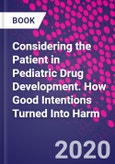Considering the Patient in Pediatric Drug Development: How Good Intentions Turned into Harm addresses a fundamental challenge in drug development and healthcare for young patients. In clinical trials and clinical practice, the term "children" is used ambiguously to confer physiological characteristics to a chronological age limit, which in reality does not exist. This book outlines why the United States (US) and European Union's (EU) regulatory authorities, pediatric academia, and the pharmaceutical industry demand, support and perform pediatric drug studies, along with the key flaws of this demand that blurs the different administrative and physiological meanings of the term "child."
In addition, the book covers why most pediatric regulatory studies lack medical sense and many even harm young patients and the conflicts of interest behind pediatric drug studies. It includes relevant information about the maturation of the human body regarding absorption, distribution, metabolism and excretion of food and drugs as well as key differences between newborns, infants, older children and adolescents.
Please Note: This is an On Demand product, delivery may take up to 11 working days after payment has been received.








